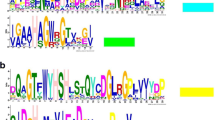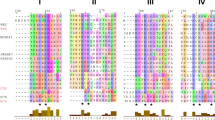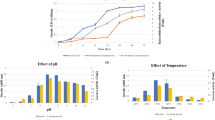Abstract
Laccases from various sources like higher plants, fungi as well as bacteria are known to have wide range of applications in various industries such as paper, textile and beverage. This enzyme is extensively studied because of its vital role in bioremediation, biosensors and diagnostics. Phylogenetic analysis of retrieved sequences of laccases from selected bacteria and fungi inferred variation in sequences and these laccases were grouped independently. All laccases of selected organisms are acidic showing computed pI < 7 and hydrophilic in nature. Presence of disulfide bridges was observed in laccases of bacteria Pseudomonas putida, Haemophilus parasuis HPS11 and Endozoicomonas numazuensis as well as in all selected fungal laccases. N-myristoylation and phosphorylation sites for Protein kinase C and Casein kinase II were found in all selected laccases. Secondary structure prediction revealed dominance of random coils in selected laccases. Validation results of predicted 3D structures of laccase enzymes confirmed that the modeled structures were of good quality. All selected bacterial laccases were intracellular and those of fungal were found to be extracellular. These investigations provide functional information about these laccases and may help to design successful experimental work aiming towards isolation and purification of laccases from closely related organisms. Experimental structures of these laccase enzymes are not yet available, so till then this study will provide a platform for knowing the structural organization responsible for functioning of these enzymes.



Similar content being viewed by others
References
Archibald S, Bourbonnais R, Jurasek L, Paice M, Reid I (1997) Kraft pulp bleaching and delignification by Trametes versicolor. J Biotechnol 53:215–336
Benfield G, Bocks S, Bromley K, Brown B (1964) Studies in fungal and plant laccases. Photochemistry 3:79–88
Benkert P, Biasini M, Schwede T (2011) Toward the estimation of the absolute quality of individual protein structure models. Bioinformatics 27(3):343–350
Bradbury A, Smyth D (1991) Peptide amidation. Trends Biochem Sci 16:112–115
Bradshaw RA (1989) Protein translocation and turn-over in eukaryotic cells. Trends Biochem Sci 14:276–279
Buxbaum E (2007) Fundamentals of protein structure and function. Springer, New York
Cohen P (2000) The regulation of protein function by multisite phosphorylation: a 25 year update. Trends Biochem Sci 25:596–601
Colovos CV, Yeates TO (1993) Verification of protein structures: patterns of non bonded atomic interactions. Protein Sci 11:681–684
Combet C, Blanchet C, Geourjon C, Deléage G (2000) NPS@: network protein sequence analysis. Trends Biochem Sci 25:147–150
Cristobal S, Zemla A, Fischer D, Rychlewski L, Elofsson A (2001) A study of quality measures for protein threading models. BMC Bioinform 2:5
Diamantidis G, Effose A, Potier P, Bally R (2000) Purification and characterization of the first bacterial laccase in rhizospheric bacteria Azospirillum lipoferum. Soil Biol Biochem 32:919–927
Faure D, Bouillant M, Bally R (1994) Isolation of Azospirillum lipoferum 4T Tn5 mutants affected in melanisation and laccase activity. Appl Environ Microbiol 60:3413–3415
Faure D, Bouillant M, Bally R (1995) Comparative study of substrates and inhibitors of Azospirillum lipoferum and Pyricularia oryzae laccases. Appl Environ Microbiol 61:1144–1146
Gary W (2009) Post-translational modifications in the context of therapeutic proteins: an introductory overview. In: Walsh G (ed) Post-translational modification of protein biopharmaceuticals. Wiley, Weinheim, Germany, pp 1–14
Gasteiger E, Hoogland C, Gattiker A, Duvaud S, Wilkins MR, Appel RD, Bairoch A (2005) Protein identification and analysis tools on the ExPASy server. In: Walker JM (ed) The proteomics protocols handbook. Humana Press, pp 571–607
Gill S, Hippel V (1989) Calculation of protein extinction coefficients from amino acid sequence data. Anal Biochem 182:319–326
Givaudan A, Effosse A, Faure D, Potier P, Bouillant ML, Bally R (1993) Polyphenol oxidase in Azospirillum lipoferum isolated from rice rhizosphere : evidence for laccase activity in nonmotile strains of Azospirillum lipoferum. FEMS Microbiol Lett 108:205–210
Guruprasad K, Reddy B, Pandit M (1990) Correlation between stability of a protein and its dipeptide composition: a novel approach for predicting in vivo stability of a protein from its primary sequence. Prot Eng 4:155–161
Ikai A (1980) Thermostability and aliphatic index of globular proteins. J Biochem 88:1895–1896
Kunamneni A, Plou Fransico J, Ballesteros A, Alcalde M (2008) Laccase and their applications: a patent review. Recent Pat Biotechnol 2(1):10–24
Kyte J, Doolittle R (1982) A simple method for displaying the hydropathic character of a protein. J Mol Biol 157:105–132
Larkin M, Blackshield G, Brown N (2007) Clustal W and clustal X version 2.0. Bioinformatics 23(21):2947–2948
Lovell S, Davis I, Arendall W III, de Bakker P, Word J, Prisant M, Richardson J, Richardson D (2002) Structure validation by C alpha geometry: phi, psi and C beta deviation. Protein Struct Funct Genet 50:437–450
Majcherczyk A, Johannes C, Huttermann A (1998) Oxidation of polycyclic aromatic hydrocarbons (PAH) by laccase of Trametes versicolor. Enzyme Microb Technol 22:335–341
Martins LO, Soares CM, Pereira MM, Teixeira M, Costa T, Jones GH, Henriques AO (2002) Molecular and biochemical characterization of a highly stable bacterial laccase that occurs as a structural component of the Bacillus subtilis endospore coat. J Biol Chem 277:18849–18859
Minussi R, Pastore G, Duran N (2002) Potential application of laccase in the food industry. Trends Food Sci Technol 3:205–216
Nakashima H, Nishikawa K (1994) Discrimination of intracellular and extracellular proteins using amino acids composition and residue-pair frequencies. J Mol Biol 283:54–61
Olsen HB, Kaarsholm NC (2000) Structural effects of protein lipidation as revealed by LysB29-MYRISTOYL, desi (B30) insulin. Biochemistry 39:11893–11900
Pagni M, Ioannidis V, Cerutti L, Zahn-Zabal M, Jongeneel CV, Hau J, Martinn O, Kuznetsov D, Falquet L (2007) MyHits: improvements to an interactive resource for analyzing protein sequences. Nucl Acid Res 35:433–437
Podell S, Gribskov M (2004) Predicting N-terminal myristoylation sites in plant proteins. BMC Genomics 5:37
Ranocha P, McDougall G, Hawkins S, Sterjiades R, Borderies G, Stewart D, Cabanes-Macheteau M, Boudet AM, Goffner D (1999) Biochemical characterization, molecular cloning and expression of laccases: a divergent gene family in poplar. Eur J Biochem 259:485–495
Rogalski J, Leonowicz A (2004) Laccase. In: Pandey A (ed) Concise encyclopaedia of bioresourse technology. Food Product Press, Haworth Reference Press, New York, pp 533–542
Rogers S, Wells R, Rechsteiner M (1986) Science 234:364–368
Schlosser D, Grey R, Fritsche W (1997) Patterns of ligninolytic enzymes in T. Versicolor distribution of extra- and intracellular enzyme activities during cultivation on glucose, wheat straw and beech wood. Appl Microbiol Biotechnol 47:412–418
Schwede T, Kopp J, Guex N, Peitsch M (2003) SWISS-MODEL: an automated protein homology-modelling server. Nucl Acid Res 31:3381–3385
Skorobogat’ko O, Gindilis A, Troitskaya E, Shuster A, Yaropolov A (1994) Laccase as new enzymatic label for enzyme immunoassay. Anal Lett 27(15):2997–3012
Solano F, Garcia E, Perez de Egea E, Sanchez-Amat A (1997) Isolation and characterization of strain MMB-1 a novel melanogenic marine bacterium. Appl Environ Microbiol 63:3499–3506
Swamy J, Ramsy J (1999) The evaluation of white rot fungi in the decolouration of textile dyes. Enzyme Microb technol 24:130–137
Tamura K, Dudley J, Nei M, Kumar S (2007) MEGA4: molecular evolutionary genetics analysis (MEGA) software version 4.0. Mol Biol Evol 24:1596–1599
Thurston C (1994) The structure and function of fungal laccase. Microbiology 140:19–26
Vernekar M, Lele S (2009) Laccase: properties and applications. Bioresources 4(4):1694–1717
Wood DA (1980) Production, purification and properties of extracellular laccase during fruiting of Agaricus bisporus. J Gen Mcrobiol 117:339–345
Xu F (1996) Oxidation of phenols, anilines and benzene thiols by fungal laccases: correlation between activity and redox potentials as well as halide inhibition. Biochemistry 17:7608–7614
Xu F (1999) Laccase. In: Flickinger MC, Drew SW (eds) Encyclopaedia of bioresource technology: fermentation, biocatalysis, bioseparation. Wiley, New York, pp 1545–1554
Yoshida H (1883) Chemistry of lacquer (urichi). J Chem Soc Trans 43:472–486
Yu C, Chen Y, Lu C, Hwang J (2006) Prediction of protein subcellular localization. Protein Struct Funct Bioinform 64:643–651
Zhang J, Knighton DR, Xuong NH, Taylor SS, Sowadski JM, Ten Eyck LF (1993) Crystal structures of the myristoylated catalytic subunit of Camp-dependent protein kinase reveal open and closed conformations. Protein Sci 2:1559–1573
Acknowledgments
Authors are thankful to the Department of Biotechnology, New Delhi, India for funding under Interdisciplinary Program on Life Sciences for advanced Research and Education (Grant No. BT/PR4572/INF/22/147/2012) to Shivaji University, Kolhapur, India.
Author information
Authors and Affiliations
Corresponding author
Electronic supplementary material
Below is the link to the electronic supplementary material.
Rights and permissions
About this article
Cite this article
Tamboli, A.S., Rane, N.R., Patil, S.M. et al. Physicochemical characterization, structural analysis and homology modeling of bacterial and fungal laccases using in silico methods. Netw Model Anal Health Inform Bioinforma 4, 17 (2015). https://doi.org/10.1007/s13721-015-0089-y
Received:
Revised:
Accepted:
Published:
DOI: https://doi.org/10.1007/s13721-015-0089-y




